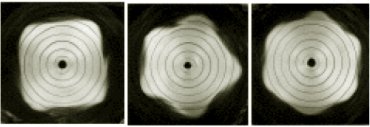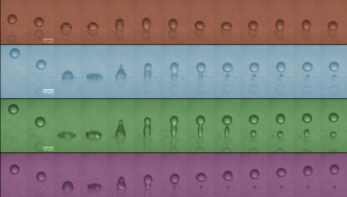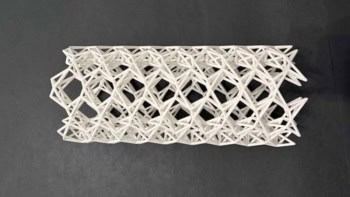
If you were in a spacecraft passing over the Earth’s South Pole, you are likely to see a “polar vortex” — a huge swirling mass of clouds and winds in the upper atmosphere right above the pole, driven by the Earth’s rotation. The centre of the vortex is usually circular, but occasionally it assumes a triangular or even a square shape. Now researchers in Canada claim to have replicated this behaviour for the first time in the laboratory — using nothing more than water in a cylindrical bucket with a rotating base.
While it might seem strange that a circular vortex will suddenly develop corners, this curious behaviour was first hinted at over a century ago by the British physicist J J Thomson. Working on the now long-abandoned theory of “vortex atoms”, which assumed that each atom is a vortex in the ether, Thomson calculated that when a single vortex reaches a critical angular velocity, it will split into two vortices that orbit each other, making a diatomic molecule.
As the angular velocity increased further, Thomson predicted that the system would separate into three, four, five and six vortices, creating larger molecules. This idea of multiple vortices was largely forgotten until 1979, when Richard Packard and colleagues at the University of California, Berkeley saw as many as 11 vortices in a rotating cylinder of superfluid helium (Phys Rev Lett 43 214).
Some physicists believe that the curious polygonal shapes of the polar vortex could be formed when multiple “satellite vortices” coexist with a central vortex. For example three satellite vortices and a central vortex would combine to make a triangular shape. Now, Georgios Vatistas and colleagues at Concordia University may have observed this effect for the first time in the laboratory (Phys Rev Lett 100 174503 ).
Give it a whirl
Vatistas’s team studied water vortices in a stationary cylindrical bucket with a rotating disk at its bottom. As the disk spins, it causes a whirlpool to form in the bucket. The centrifugal effect causes the water to climb the wall of the bucket, leaving a depression in the centre. If the disk is spun fast enough, the depression reaches right to the bottom of the bucket and the centre of the disk has no water on it.
The researchers used a digital camera to take one photo of the dry region per revolution using a synchronized stroboscope. Initially, the dry region of the disk was circular — but as the angular velocity of the disk increased, the dry region split into two lobes, followed by a triangle, square, pentagon and hexagon. Despite further increases in angular velocity, the team saw no evidence of polygons with seven or more sides.
Vatistas told physicsworld.com that while more experimental and theoretical work is needed to understand why the polygons are being formed, he believes that they are probably created by the coexistence of a central vortex with specific configurations of satellite vortices.
“We are still observing and mapping the phenomenon in detail”, said Vatistas. Then, armed with more detailed experimental data, the team plan to use the mathematical theory of vortex formation along with numerical simulations to gain a deeper understanding of why the polygons are formed.
Saturn and beyond
Vatistas believes that the work could lead to a better understanding of the dynamics of Earth’s atmosphere. Polygonal structures have also been seen in the “eyes” at the centre of some hurricanes, for example. Beyond Earth, a hexagonal structure has been spotted at Saturn’s north pole and triangular shapes have been spotted at the centre of the spiral galaxy NGC 598 — leading some astrophysicists to suggest that its core contains three satellite vortices.
Reflecting on this latest contribution to the study of vortices, Packard at Berkeley told physicsworld.com “I do find it fascinating that vortices, which occur in so many places in nature, are still the object of research after over two hundred years of scrutiny by some of the best minds in science”.



